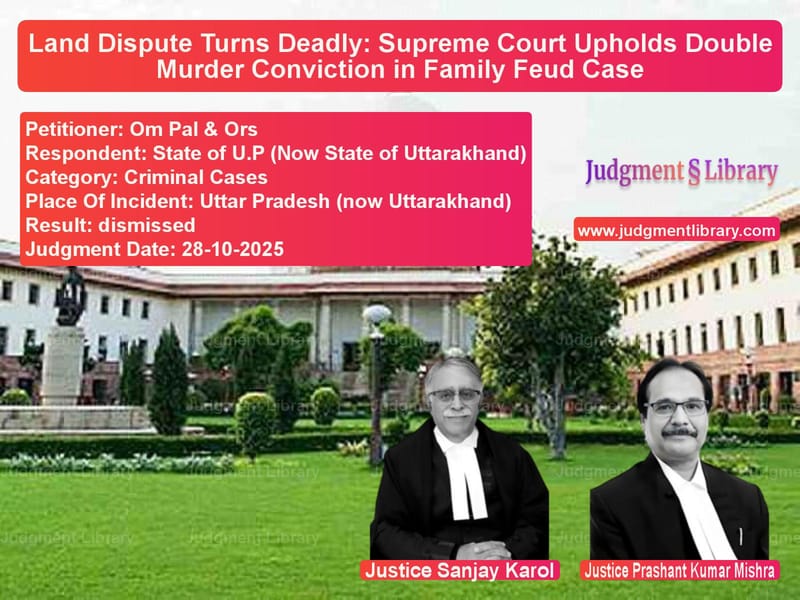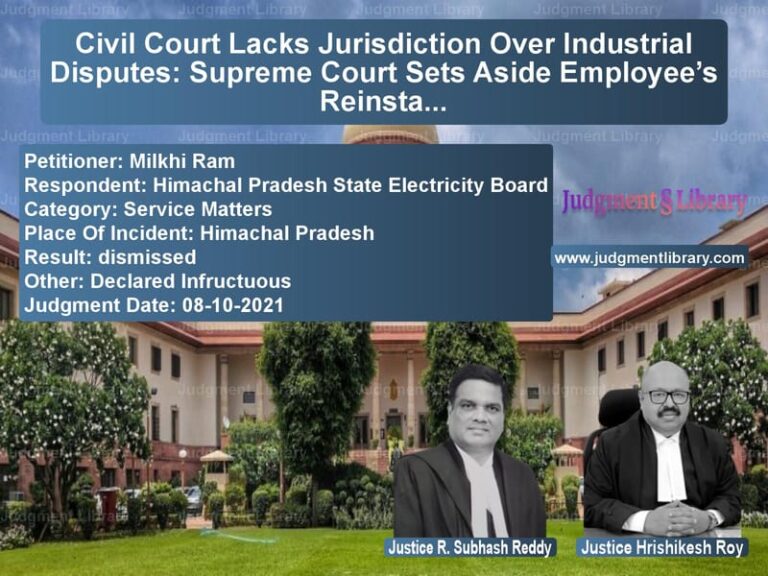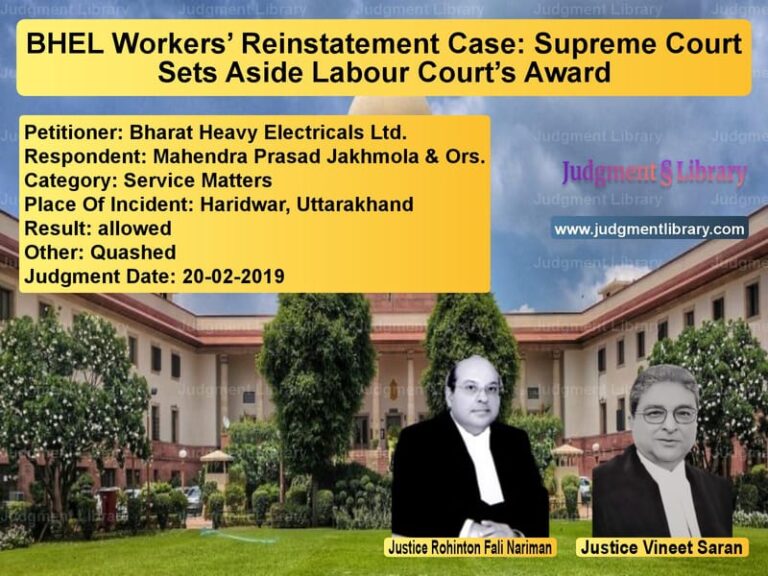Land Dispute Turns Deadly: Supreme Court Upholds Double Murder Conviction in Family Feud Case
In a tragic tale of how long-standing family disputes over land can escalate into fatal violence, the Supreme Court of India recently delivered a judgment that underscores the serious consequences of taking the law into one’s own hands. The case, which originated from an incident dating back to 1988, involved two families who were close relatives but became embroiled in a bitter conflict over farmland boundaries.
The story begins on May 19, 1988, in a rural setting where both families were engaged in agricultural activities. What started as a routine day of cutting sugarcane quickly turned violent when members of one family allegedly damaged the boundary ridge (known as ‘mendh’) separating their field from their relatives’ property. This seemingly minor act of destroying a farmland boundary would ultimately claim two lives and change multiple families forever.
The Conflicting Stories
Interestingly, both sides filed police reports about the same incident, each presenting a dramatically different version of events. The appellants – Om Pal, Narendra, Ranvir, Dharamvir, and others – filed the first police report (FIR No.65) on May 20, 1988. They claimed that they were the victims, stating that while they were cutting sugarcane, Dile Ram, Ved Pal, Bengal Singh, and Sher Singh entered their field armed with lathis, tabals, and axes and attacked them. According to their version, Kantu, Narendra, and Inchha received several injuries in this attack.
However, three days later, on May 23, 1988, the opposite side filed their own police report (FIR No.65A). They told a completely different story, alleging that Molhar and Dharamvir Singh had damaged their field boundary on May 19, 1988, after which the appellants started beating Dile Ram with lathis, tabals, axes, and phawara. This assault resulted in serious injuries to Dile Ram, Braham Singh, and Bangal Singh. Both injured men were taken to the hospital, where Dile Ram succumbed to his injuries on May 24, 1988, and Braham Singh passed away on May 31, 1988.
The Legal Journey
These two conflicting police reports led to separate criminal trials. The trial arising from the appellants’ FIR (Session Trial No.57 of 1992) resulted in the acquittal of all accused persons from the complainant side. However, the trial stemming from the complainant’s FIR (Session Trial No.56 of 1992) ended with all seven accused persons being found guilty of murder and attempted murder.
The Trial Court convicted them under Section 302 read with Section 149 of the Indian Penal Code (murder as part of an unlawful assembly) and Section 307 read with Section 149 IPC (attempt to murder as part of an unlawful assembly). Each was sentenced to imprisonment for life and a fine of ₹10,000 under the murder charge, plus rigorous imprisonment for 10 years and another ₹10,000 fine for the attempted murder charge. Additional sentences were imposed for other offenses.
When the appellants challenged their conviction before the Allahabad High Court, their appeals were dismissed. The cases were later transferred to the Uttarakhand High Court after the formation of the new state, which also upheld the conviction. The appellants then approached the Supreme Court as their last legal recourse.
The Arguments Before the Supreme Court
The appellants’ lawyers made several key arguments before the Supreme Court. They contended that this was not a case of premeditated murder but rather a ‘free fight’ that erupted between the two groups. Since both sides sustained injuries, they argued that the possibility of the appellants exercising their right to self-defense couldn’t be ruled out. They also pointed out that none of the witnesses could attribute specific roles to particular accused persons, which they claimed indicated it was indeed a case of mutual combat.
Another significant argument was about the timing of the police reports. The appellants emphasized that their side had lodged the first FIR, while the cross-complaint from the complainant side was filed three days after the incident by the son of deceased Dile Ram, not by an injured eyewitness. The appellants’ counsel questioned the reliability of the eyewitness testimonies and argued that even if the appellants were liable, their case should fall under the fourth exception to Section 300 IPC, making them liable only under Section 304 Part II (culpable homicide not amounting to murder) rather than murder.
To support their position, the appellants relied on several Supreme Court decisions including Puran vs. State of Rajasthan, Pappu vs. State of M.P., Kailash vs. State of M.P., Vadla Chandraiah vs. State of A.P., and Sandhya Jadhav vs. State of Maharashtra.
The State, however, presented a different picture. They argued that the appellants had a clear motive for the attack – ongoing consolidation proceedings between the parties had resulted in the disputed field being awarded to Dile Ram, which had enraged the appellants. The State maintained that the appellants were the aggressors who initiated the attack on the complainant side.
An important point raised by the State was about the weapons used. PW-2 (Bangal Singh), an injured eyewitness, had testified that the appellants’ lathis contained arc-shaped iron blades. The State argued that the fourth exception to Section 300 IPC didn’t apply because the appellants shared a common motive to cause death. Regarding the delay in filing the FIR, the State contended that the Trial Court had already rejected this argument as the delay was satisfactorily explained by the complainant side.
The State relied on Supreme Court decisions in Pulicherla Nagaraju alias Nagaraja Reddy vs. State of A.P. and Abdul Sayeed vs. State of Madya Pradesh to support their position.
The Supreme Court’s Analysis
The Supreme Court began its analysis by acknowledging that it generally hesitates to interfere with concurrent findings by two courts below. The Court quoted from its earlier decision in Mekala Sivaiah vs. State of Andhra Pradesh: “It is well settled by judicial pronouncement that Article 136 is worded in wide terms and powers conferred under the said Article are not hedged by any technical hurdles. This overriding and exceptional power is, however, to be exercised sparingly and only in furtherance of cause of justice. Thus, when the judgment under appeal has resulted in grave miscarriage of justice by some misapprehension or misreading of evidence or by ignoring material evidence then this Court is not only empowered but is well expected to interfere to promote the cause of justice.”
The Court further elaborated on the scope of its power under Article 136 by referencing Shahaja alias Shahajan Ismail Mohd. Shaikh vs. State of Maharashtra: “The powers of this Court under Article 136 of the Constitution are very wide but in criminal appeals this Court does not interfere with the concurrent findings of fact save in exceptional circumstances.”
Examining the facts, the Court noted that the parties were close relatives descended from a common ancestor, with a long-standing dispute over land boundaries. The altercation occurred when the appellants broke the mendh (ridge) between the farmlands, leading to injuries on both sides and ultimately the deaths of Dile Ram and Braham Singh.
The Evidence That Sealed the Case
The prosecution’s case relied heavily on eyewitness accounts, particularly PW-2 (Bangal Singh), an injured eyewitness. He testified that on the day of the incident, his grandfather Dile Ram and uncle Braham Singh were working in the sugarcane field when at about 11:00 A.M., Molhar and Dharamvir damaged the field’s boundary ridge. When Dile Ram objected, Molhar and Dharamvir started hurling abuses and called other accused persons including Kantu, Inchha Ram, Narendra, Om Pal, and Ranvir. According to his testimony, Dharamvir and Inchha Ram were armed with spades while others carried lathis, and they assaulted both deceased persons and PW-2 with these dangerous weapons.
The Court emphasized the special status of injured eyewitness testimony in law, quoting from Jarnail Singh & Ors. vs. State of Punjab: “Darshan Singh (PW 4) was an injured witness. He had been examined by the doctor. His testimony could not be brushed aside lightly. He had given full details of the incident as he was present at the time when the assailants reached the tubewell. In Shivalingappa Kallavanappa v. State of Karnataka this Court has held that the deposition of the injured witness should be relied upon unless there are strong grounds for rejection of his evidence on the basis of major contradictions and discrepancies, for the reason that his presence on the scene stands established in case it is proved that he suffered the injury during the said incident.”
The Court further referenced Abdul Sayeed vs. State of Madya Pradesh, noting that “injury to the witness is an inbuilt guarantee of his presence at the scene of the crime.” Since the defense hadn’t challenged PW-2’s version and had actually admitted his presence at the spot, the Court found his testimony reliable.
Other eyewitnesses (PW-3 and PW-4) corroborated this account, stating they were taking their bullock-carts loaded with sugarcane on the nearby road when they heard the commotion and arrived at the spot. They also saw the demolished boundary ridge. The defense failed to elicit any significant contradictions from these witnesses during cross-examination.
The Nature of Injuries
The medical evidence revealed the severity of the injuries inflicted. Dile Ram had suffered an incised wound 13½ cm long and 2 cm wide, bone deep over the parietal region. Braham Singh had multiple injuries including an incised wound 13 cm long and 2 cm wide, bone deep over the left parietal region of the skull, along with several lacerated wounds. Bangal Singh also sustained multiple injuries including lacerated wounds on his head.
Some appellants had also sustained injuries – Narendra had a lacerated wound on his head and incised wounds on his finger; Om Pal had various abrasions and contusions; and Inchha Ram had multiple lacerated wounds on his head and other injuries. However, the Court noted the significant difference in the nature of injuries – the deceased had suffered fatal wounds from sharp weapons on vital parts of their bodies, while the appellants’ injuries were less severe.
Rejecting the ‘Free Fight’ Argument
One of the appellants’ main arguments was that this was a case of ‘free fight’ that should fall under the fourth exception to Section 300 IPC. The Court rejected this contention, relying on Pulicherla Nagaraju alias Nagaraja Reddy vs. State of A.P.: “Therefore, the court should proceed to decide the pivotal question of intention, with care and caution, as that will decide whether the case falls under Section 302 or 304 Part I or 304 Part II. Many petty or insignificant matters — plucking of a fruit, straying of cattle, quarrel of children, utterance of a rude word or even an objectionable glance, may lead to altercations and group clashes culminating in deaths. Usual motives like revenge, greed, jealousy or suspicion may be totally absent in such cases. There may be no intention. There may be no premeditation… The intention to cause death can be gathered generally from a combination of a few or several of the following, among other, circumstances: (i) nature of the weapon used; (ii) whether the weapon was carried by the accused or was picked up from the spot; (iii) whether the blow is aimed at a vital part of the body; (iv) the amount of force employed in causing injury; (v) whether the act was in the course of sudden quarrel or sudden fight or free for all fight…”
The Court found that the nature and extent of injuries, particularly the use of sharp-edged weapons like spades and phawadas to deliver fatal blows to the heads of the deceased, demonstrated that the assailants acted with a clear intention to cause death.
Other Legal Issues
The Court also addressed other legal issues raised by the appellants. Regarding the delay in filing the FIR, the Court referenced State of H.P. vs. Gian Chand: “Delay in lodging the FIR cannot be used as a ritualistic formula for doubting the prosecution case and discarding the same solely on the ground of delay in lodging the first information report. Delay has the effect of putting the court on its guard to search if any explanation has been offered for the delay, and if offered, whether it is satisfactory or not.” The Court found the explanation satisfactory – PW-1 (Teipal Singh, son of deceased Dile Ram) had taken the injured to the hospital in Chandigarh and only after returning on May 23, 1988, did he lodge the FIR.
On the non-recovery of weapons, the Court cited State of Rajasthan vs. Arjun Singh & Ors.: “As rightly pointed out by the learned Additional Advocate General appearing for the State that mere non-recovery of pistol or cartridge does not detract the case of the prosecution where clinching and direct evidence is acceptable.” The Court found that the consistent medical and ocular evidence made the non-recovery of weapons inconsequential.
The Final Verdict
After thorough analysis, the Supreme Court concluded: “From the above discussion, there remains no doubt in our minds that the present appellants in furtherance of their common intention formed an unlawful assembly. Inchha and Dharamvir stood armed with sharp edged deadly weapons committed the murder of Braham Singh and Dile Ram, while in order to achieve their common intention, they had also inflicted such injuries on the physical person of Bangal Singh knowing fully well that had Bangal Singh died on account of the said injuries they ought to have been held guilty of causing his murder in this matter.”
The Court dismissed all appeals, directing the appellants to surrender to custody immediately. However, the Court clarified that nothing prevented the appellants from applying for remission in accordance with law and the state government’s policy, and if such application were made, it should be considered on its own merits.
This judgment serves as a stark reminder that land disputes, however emotionally charged, must be resolved through legal channels rather than violence. When conflicts escalate into physical confrontations with deadly weapons, the consequences can be devastating – lives lost, families shattered, and prison terms for those who take the law into their own hands. The Supreme Court’s meticulous analysis of evidence and legal principles in this three-decade-old case demonstrates the enduring pursuit of justice, even when delayed by the slow wheels of the legal process.
Petitioner Name: Om Pal & Ors.Respondent Name: State of U.P (Now State of Uttarakhand).Judgment By: Justice Sanjay Karol, Justice Prashant Kumar Mishra.Place Of Incident: Uttar Pradesh (now Uttarakhand).Judgment Date: 28-10-2025.Result: dismissed.
Don’t miss out on the full details! Download the complete judgment in PDF format below and gain valuable insights instantly!
Download Judgment: om-pal-&-ors-vs-state-of-u.p-(now-st-supreme-court-of-india-judgment-dated-28-10-2025.pdf
Directly Download Judgment: Directly download this Judgment
See all petitions in Murder Cases
See all petitions in Attempt to Murder Cases
See all petitions in Bail and Anticipatory Bail
See all petitions in Custodial Deaths and Police Misconduct
See all petitions in Judgment by Sanjay Karol
See all petitions in Judgment by Prashant Kumar Mishra
See all petitions in dismissed
See all petitions in supreme court of India judgments October 2025
See all petitions in 2025 judgments
See all posts in Criminal Cases Category
See all allowed petitions in Criminal Cases Category
See all Dismissed petitions in Criminal Cases Category
See all partially allowed petitions in Criminal Cases Category







